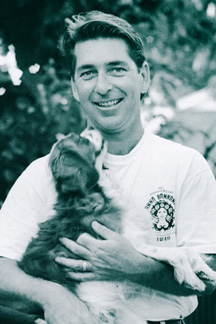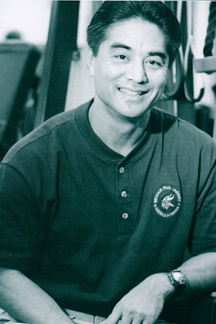
|
Brother Noland’s book
offers reminders
of aloha spirit
People have been asking for years if the aloha spirit is dead and gone. Brother Noland Conjugacion would definitely say no.

"The Lessons of Aloha: Stories of the Human Spirit"with Brother Noland
(Watermark Publishing,
|
"People just need to be reminded," Conjugacion said. "We are all born with it but slowly get reconditioned."
Children have an abundance of the aloha spirit and don't even know it, he said. Keeping it alive is the hard part.
Conjugacion, better known for his long musical career as Brother Noland, does his part with a new book, "The Lessons of Aloha: Stories of the Human Spirit," a collection of inspirational stories. Each has a moral or a lesson, as told by local people in their own words.
"In all of the emotion, there was humor," Conjugacion said.
Aloha implies love, respect and all the values of a good education, he said, but living with aloha is not easy. "We live in a very selfish, egotistical world, cluttered with money, politics and religion. We live in a world with lots of expectations."
"The world is colorful," he added. "Anybody can talk a mean talk. I'm just thankful that I had mentors to help me down the path. It's all about the message, the good vibe. There is so much that we can share."
So many people out there are just dangling -- from the Catholic priests to the addicts on "ice," he said. "We tend to become disconnected as humans and don't know how to coexist."
One of the main reasons he wrote his book, he said, is to help readers understand how important it is to keep these stories alive.
"There is nothing like a good story ... they provide a wealth of knowledge. Whatever you are trying to teach can be done in a story. Before TV and radio, that is all we had to entertain ourselves."
He also felt it provided an avenue, aside from his music, to reach out. Recently, he has also placed much emphasis on being involved in children's programs at Palama Settlement, the Boys and Girls Club, Kamehameha Schools and the YWCA.
The book includes an array of stories based on lessons divided into seven sections: lessons within, lessons of the community, land, marketplace, arts, teamwork and Kalaupapa. The recently expanded hardcover version includes 48 stories, accompanied by Shuzo Uemoto's photos, that teach the value of helping others, how prejudgments can be reckless and how racial prejudice hurts oneself.
Among the storytellers are those who have dealt with tragedies or addiction, executives who give back to the community, artists who learned family lessons, kapuna who share wisdom and the tales of the residents of Kalaupapa.
Mary Scott Lau, executive director of Women in Need, encourages women to take control of their own lives. "I'm sorry you have bad mothers," she wrote. "But you need to break the cycle." Kelly Hill, director of Sisters Offering Support, shares her story of prostitution and her road to recovery. Ed Fukuda talks about his daily visits to a convalescent home to spend time with his father, who has Alzheimer's disease. And Mary Lou Kekuewa talks about her alcohol addiction and the pain it caused her family.
No story in the book is longer than three pages, photos are abundant and the print is large -- all Conjugacion's requirements, who said those are all attributes that would entice him to read.
As a youngster, he recalled being placed on time out with a dictionary and Bible when he misbehaved. "I would close my eyes and point to a word or scripture and read it."
He learned a lot from this practice of absorbing small bits of information and used the technique in his book: Each story is accompanied by boxed tidbits of information. Some boxes include quotes from the storyteller, others a minibiography.
In Fukuda's story, for example, the little bit of information reads, in part: "After graduating from Hilo High School in 1952, he worked for 20 years as a mechanic and gas attendant at his father's service station. Then, 35 years ago, he and his wife Judy founded Kandi's Drive Inn. Today his daughter, his only child, operates the drive-in, and his son-in-law operates the service station. Meanwhile, Ed keeps his father connected to the family by visiting him every day at the nursing home."
Conjugacion firmly believes that every action or situation is life has a lesson of aloha. "Along my journey, I've come across so many situations and moments that were turning points in my life. I continue to live as a child with an old soul in my body. Everything I live and express, I was taught. I'm just continuing the spirit of aloha."
Excerpts from
‘Lessons of Aloha’

Wall Builder
Everybody get their own style for make rock wall. Some use diamond blade to cut. That way, guarantee you get one tight fit. Look nice, like tile, but I prefer to work with the natural shape of each stone. It's all wedged together, rock on rock, sleeved in by its own weight. I use very little mortar. What cement I use is in the back, without the grout face. It's like a puzzle. It's hard to work with curves, but to me, curves get flow, movement.
I call this type of work "rock therapy" because it teaches me patience and self-discipline. It used to be if I wished for something today, I want it tomorrow. But like with the wall, you gotta wait until the cement dries before you set the rock. Take your time.
Slowly, the lessons Naka taught me seeping in. He always said the foundation, the footing, gotta be solid. I think everything starts from there. Then, however creative you like get, at least you get the basics down. Otherwise, with the pressure of the weight pushing down, the wall going kick out. You gotta dig the footing below the grade level because if you just put the rocks right on the ground, eventually the rain going erode the soil and going undercut the wall.
Usually, I study the site before I even move the first stone. I get one idea what the finished wall going look like. I take my time to pick out the cornerstones. Hard for find the corners. You go nuts looking for the 90 degrees, but if you get the cornerstones looking good, you bring the whole wall together. The cornerstones gotta look good, plus gotta be strong.
Every stone get front, back, up and down. When you work long enough, it jumps out at you. You can see the grain. If going horizontal, you no like make 'em go vertical. You can feel if the rock belongs there. You gotta embrace it even if it's a rock. Some days it's like nothing works, so I quit. No matter what you do, no fit. I leave it for the next day and look at it fresh again.
These days, everything's gotta be like saimin -- instant. So this job keeps me in perspective. Yeah, even with stone, you gotta try work one balance -- big and small.

Contractor
From the moment I was captured, I could only think of one thing -- how to escape. I've been in a couple of bad motorcycle accidents before, but that day I really thought, "This is it." My mind was racing, looking for an opportunity -- but nothing came.
John Miranda wanted to kill Guy George for laying him off. He pointed the shotgun at him and blew his calf away. Guy lay there -- looked like he'd bleed to death. But he managed to escape out a window, so then Miranda had one of the other hostages tape the shotgun to my neck. As we moved outside, cops were all over. SWAT dudes were dropping from a helicopter onto the roof. It was like a movie. They were still negotiating with him, but he wouldn't give up. No one knew then that he had already killed his girlfriend and was on a suicide mission.
When my friend Kimo saw Miranda's brother say on the news that "John's a good guy," he freaked out. He walked down the road to the TV station. On the air Kimo says, "If anyone's a good guy in this story, it's that guy with the gun to his head! He's my friend."
John was counting down from 60. He was going to kill me when he reached zero. At 13, I swung hard to my left. The shotgun came over my shoulder and went off right in my ear. "Boom!" Later the SWAT guys told me, "What you did is a textbook move. We train our guys for months to have the presence of mind to do that. Did you ever have weapons training?" I said, "No. Survival, man, survival."
Later, I got cards from all over the nation telling me, "I was praying for you all day." It really touched me. The situation was so out of control -- you feel alone. When I saw Kimo, he said, "You don't have any family here who'll stick up for you." That was when I finally broke down and cried like a baby -- it's so cool that people are there for you.
Still, I felt bad for John. All day, I was trying to tell him, "Man, you can live. We can all live." He chose not to. And that's so sad, because I know he didn't want to die.

Coach and counselor
I went from teaching and coaching at McKinley High School to working with at-risk kids in the Special Motivation Program at Dole Intermediate. It was a tough adjustment. These kids real kolohe, so my goal was to get them disciplined. In the beginning, I thought you have to make it real tough. After a while, though, I realized something was missing. In high school -- teaching, coaching -- at the end of the year, you felt appreciated. Now, because I set myself up to be the bad guy, nobody ever said to me, "Eh, thanks for being tough on me."
I had to change my approach. I had made them listen but that's not enough. They weren't going to get better at academics or anything else unless they felt good about themselves. So my goal became to build up their self-esteem.
First, I had them do campus beautification projects -- take pride in their school. But the connotation was, "You guys in trouble; you probably was the ones who messed it up anyway."
I had to work with the kids in a setting where they could just be themselves, so I took them to preschools and senior citizen centers. Working with the seniors and little kids, they not going show off; they don't have to act macho; they have nothing to prove.
I told them, "When we go there, you're going to be the teachers." For Halloween we made masks, small goodie bags. Working with the little kids, a different side of them comes out. They feel appreciated. And it was real touching to see the young kids hugging these students before they leave. I don't know how often these guys and girls get hugged.
My hope was that this positive feeling would transfer back to a school setting. For some it worked. For some it didn't. Maybe it registered years later. I see some of them around now, and they say, "Remember when we made the haunted house and invited all the little kids?" When they reflect like that, I think it must have done something for them. It's that sparkle in their eye. I can see it in them: "That was good. I feel good."
E-mail to Features Desk
[News] [Business] [Features] [Sports] [Editorial] [Do It Electric!]
[Classified Ads] [Search] [Subscribe] [Info] [Letter to Editor]
[Feedback]
